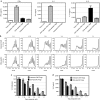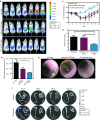Suppression of murine colitis and its associated cancer by carcinoembryonic antigen-specific regulatory T cells
- PMID: 24686242
- PMCID: PMC4015241
- DOI: 10.1038/mt.2014.41
Suppression of murine colitis and its associated cancer by carcinoembryonic antigen-specific regulatory T cells
Abstract
The adoptive transfer of regulatory T cells (Tregs) offers a promising strategy to combat pathologies that are characterized by aberrant immune activation, including graft rejection and autoinflammatory diseases. Expression of a chimeric antigen receptor (CAR) gene in Tregs redirects them to the site of autoimmune activity, thereby increasing their suppressive efficiency while avoiding systemic immunosuppression. Since carcinoembryonic antigen (CEA) has been shown to be overexpressed in both human colitis and colorectal cancer, we treated CEA-transgenic mice that were induced to develop colitis with CEA-specific CAR Tregs. Two disease models were employed: T-cell-transfer colitis as well as the azoxymethane-dextran sodium sulfate model for colitis-associated colorectal cancer. Systemically administered CEA-specific (but not control) CAR Tregs accumulated in the colons of diseased mice. In both model systems, CEA-specific CAR Tregs suppressed the severity of colitis compared to control Tregs. Moreover, in the azoxymethane-dextran sodium sulfate model, CEA-specific CAR Tregs significantly decreased the subsequent colorectal tumor burden. Our data demonstrate that CEA-specific CAR Tregs exhibit a promising potential in ameliorating ulcerative colitis and in hindering colorectal cancer development. Collectively, this study provides a proof of concept for the therapeutic potential of CAR Tregs in colitis patients as well as in other autoimmune inflammatory disorders.
Figures







Comment in
-
The other face of chimeric antigen receptors.Mol Ther. 2014 May;22(5):899-900. doi: 10.1038/mt.2014.58. Mol Ther. 2014. PMID: 24787977 Free PMC article. No abstract available.
References
-
- Loftus EV., Jr Clinical epidemiology of inflammatory bowel disease: Incidence, prevalence, and environmental influences. Gastroenterology. 2004;126:1504–1517. - PubMed
-
- Kamada N, Seo SU, Chen GY, Núñez G. Role of the gut microbiota in immunity and inflammatory disease. Nat Rev Immunol. 2013;13:321–335. - PubMed
-
- Seibold F, Brandwein S, Simpson S, Terhorst C, Elson CO. pANCA represents a cross-reactivity to enteric bacterial antigens. J Clin Immunol. 1998;18:153–160. - PubMed
-
- Ohkura N, Kitagawa Y, Sakaguchi S. Development and maintenance of regulatory T cells. Immunity. 2013;38:414–423. - PubMed
Publication types
MeSH terms
Substances
LinkOut - more resources
Full Text Sources
Other Literature Sources
Medical
Molecular Biology Databases

